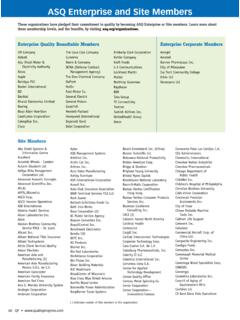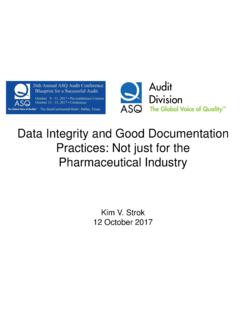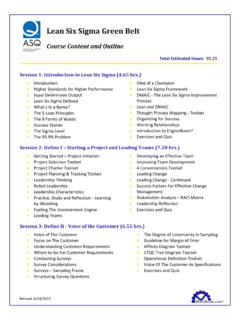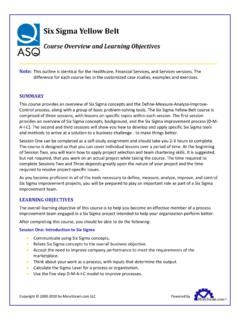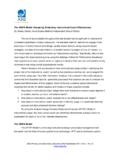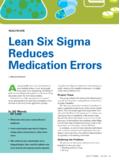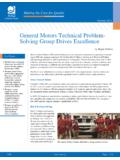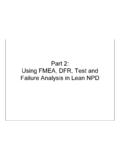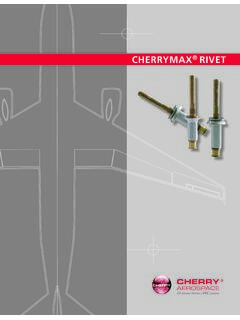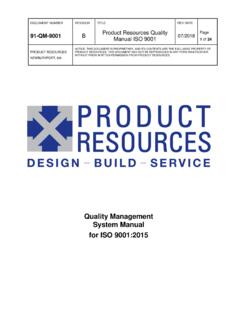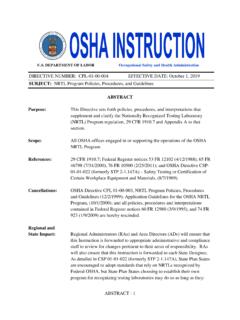Transcription of How to Establish Manufacturing Specifications
1 1 How to EstablishManufacturing SpecificationsDonald J. Wheeler1. IntroductionThe idea behind Manufacturing Specifications is to define those measurement values whichcorrespond to conforming items. That is, when the measurement falls within the manufacturingspecifications we want to be able to say that the product is within the customer Specifications . In theabsence of measurement error we could achieve this objective by simply using the customer specificationsas the Manufacturing Specifications . But when we have to make allowance for measurement error therewill need to be some gap between the Manufacturing Specifications and the customer Specifications .
2 Howto determine the size of the gap, D, and the kind of statements that we can make about the product is thetopic of this CustomerSpecificationLimitLower CustomerSpecificationLimitLower ManufacturingSpecificationLimitUpper ManufacturingSpecificationLimitWhen theMeasurementis in herethe product is likelyto be in hereDDFigure 1: The Idea Behind Manufacturing SpecificationsIf we choose a large value for D we can be very confident that the product is conforming, but wecould end up with very tight Manufacturing Specifications . When this happens there will be an increasedrisk of rejecting conforming product . By choosing a small value for D we will not have as muchconfidence that the product is conforming, but we will have looser Manufacturing Specifications with acorrespondingly smaller risk of rejecting conforming the main problem of obtaining Manufacturing Specifications is the problem of striking a balancebetween the size of the adjustment, D, and the likelihood of having a conforming item.
3 While the exactvalues will also depend on other aspects of the situation, it is these two properties that dominate theproblem. In this paper I give a set of rules for constructing Manufacturing Specifications that havedifferent likelihoods of conforming product , and then I show how these rules were to Establish Manufacturing SpecificationsDonald J. Wheeler22. Watershed SpecificationsThe concept of Watershed Specifications is fundamental to obtaining appropriate ManufacturingSpecifications. No matter how we collect our data, at some level it will always become granular and therewill be some increment in our recorded values. Traditionally Specifications express this granularity bystating the minimum and the maximum acceptable values.
4 While this is sufficient for routine usage, itcan create a problem when calculations are performed using specification values. Since we are going tobe making adjustments to the Specifications , it is important to start off with the correct baseline this end we shall have to make a correction for discrepancy between the granularity of our data andthe continuity of the underlying the minimum acceptable value is considered to be in-spec, a value that is one measurementincrement below the minimum acceptable value will be out-of-spec. Thus the actual watershed pointbetween an acceptable value and an unacceptable value is halfway in between these two values, and theLower Watershed Specification Limit is:LWSL = minimum acceptable value one-half of a measurement of to are conformingValues of and below arenonconformingValues of and above arenonconformingWhile the Specifications are commonly expressed as to ,the actual Watershed Specifications are to 2: Watershed SpecificationsLikewise, a value that is one measurement increment above the maximum acceptable value will alsobe out of spec.
5 And the upper watershed point between an acceptable value and an unacceptable value ishalfway in between these two values, making the Upper Watershed Specification Limit:UWSL = maximum acceptable value + one-half of a measurement incrementWhile we commonly express Specifications by stating the minimum and maximum acceptable values,the actual Specifications are the Watershed Specifications defined here. Their use is assumed throughoutthe computations and characterizations that to Establish Manufacturing SpecificationsDonald J. Wheeler33. Manufacturing Specifications85% Manufacturing SpecificationsIf you want to have at least a 85 percent chance that the measured item is in spec when the measure-ment falls within the Manufacturing Specifications , then you will need to tighten up the WatershedSpecification Limits by One Probable Error on each end, and use these tightened specs as your 85% Manufacturing Specifications .
6 If we use the usual notation and let e denote the standard deviation ofrepeated measurements of the same thing, then One Probable Error will be e. For two-sided speci-fications this adjustment for measurement error consumes e of the difference between the WatershedSpecification Limits, which shall be referred to in the following as the Watershed Manufacturing SpecificationsIf you want to have at least a 96 percent chance that the measured item is in spec when the measure-ment falls within the Manufacturing Specifications , then you will need to tighten up the WatershedSpecification Limits by Two Probable Errors, or e on each end, and use these tightened specs as your96% Manufacturing Specifications .
7 For two-sided Specifications this adjustment for measurement errorconsumes e of the Watershed Manufacturing SpecificationsIf you want at least a 99 percent chance that you are shipping good stuff, your 99% ManufacturingSpecifications will be the Watershed Specification Limits tightened by Three Probable Errors, or e oneach end. For two-sided Specifications this adjustment for measurement error consumes e of theWatershed Tolerance. (Not the e of popular fiction.) Manufacturing SpecificationsIf you want at least a percent chance that you are shipping good stuff, your ManufacturingSpecifications will be the Watershed Specification Limits tightened by Four Probable Errors, or e oneach end.
8 For two-sided Specifications this adjustment for measurement error consumes e of theWatershed Tolerance. (Rather than the e promoted by some.)As we will see in the following sections these adjustments to Specifications are not some arbitraryguidelines given without rationale or justification. They are the proper way to adjust the Specifications toallow for the effects of measurement those cases where the customer Specifications are so close together that your preferred manufactur-ing Specifications are not at least one measurement increment apart, you will have to be content withmanufacturing Specifications with a lower likelihood.
9 When the Specifications are so tight that 85% Manufacturing Specifications cannot be used, you will be left with a substantial possibility that you areshipping nonconforming product . When the Watershed Specifications are used as the ManufacturingSpecifications you will have a likelihood of conforming product that varies from approximately 64% at acapability of to 83% at a capability of strategy for dealing with excessively tight Manufacturing Specifications is to use the averageof multiple determinations. Such averages of n measurements will have a Probable Error that is smallerby the square root of n. This will result in slightly wider Manufacturing Specifications .
10 While this may beexpensive, it can be cheaper than a fine from a regulatory body, or an unhappy to Establish Manufacturing SpecificationsDonald J. Wheeler4 There are many different concepts tied up in these rules for obtaining Manufacturing following sections will explain each of these concepts in turn, and eventually will they will all becombined to develop a probability model that will justify the rules given Predictable Measurement SystemsUntil a measurement process is operated in a predictable manner, it cannot be said, in any logicalsense, to measure anything at all. For this reason, the first thing to do when studying, or operating, anymeasurement system is to obtain repeated measurements of a designated standard, or a known standard,and to place these measurements on a process behavior chart.

